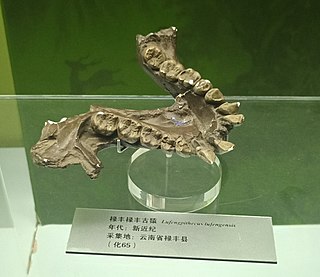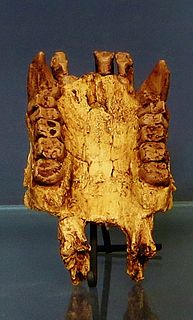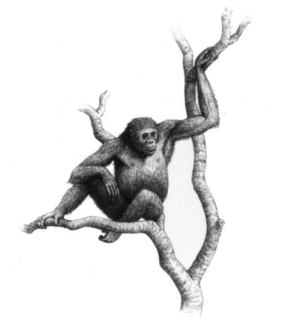
Apes are a branch of Old World tailless simians native to Africa and Southeast Asia. They are the sister group of the Old World monkeys, together forming the catarrhine clade. They are distinguished from other primates by a wider degree of freedom of motion at the shoulder joint as evolved by the influence of brachiation. In traditional and non-scientific use, the term "ape" excludes humans, and can include tailless primates taxonomically considered monkeys, and is thus not equivalent to the scientific taxon Hominoidea. There are two extant branches of the superfamily Hominoidea: the gibbons, or lesser apes; and the hominids, or great apes.

Pierolapithecus catalaunicus is an extinct species of primate which lived about 13 million years ago during the Miocene in what is now Hostalets de Pierola, Catalonia, Spain, giving it its scientific name. It is believed by some to be a common ancestor of both modern humans and the other great apes, or at least a species that is closer to a common ancestor than any previous fossil discovery.

Sivapithecus is a genus of extinct apes. Fossil remains of animals now assigned to this genus, dated from 12.2 million years old in the Miocene, have been found since the 19th century in the Siwalik Hills of the Indian subcontinent as well as in Kutch. Any one of the species in this genus may have been the ancestor to the modern orangutans.

Proconsul is an extinct genus of primates that existed from 21 to 14 million years ago during the Miocene epoch. Fossil remains are present in Eastern Africa including Kenya and Uganda. Four species have been classified to date: P. africanus, P. gitongai, P. major and P. meswae. The four species differ mainly in body size. Environmental reconstructions for the Early Miocene Proconsul sites are still tentative and range from forested environments to more open, arid grasslands.

Dryopithecus is a genus of extinct great apes from the middle–late Miocene boundary of Europe 12.5 to 11.1 million years ago (mya). Since its discovery in 1856, the genus has been subject to taxonomic turmoil, with numerous new species being described from single remains based on minute differences amongst each other, and the fragmentary nature of the holotype specimen makes differentiating remains difficult. There is currently only one uncontested species, the type species D. fontani, though there may be more. The genus is placed into the tribe Dryopithecini, which is either an offshoot of orangutans, African apes, or is its own separate branch.

Ouranopithecus is a genus of extinct Eurasian great ape represented by two species, Ouranopithecus macedoniensis, a late Miocene hominoid from Greece and Ouranopithecus turkae, also from the late Miocene of Turkey.

Nakalipithecus nakayamai is an extinct species of great ape from Nakali, Kenya, from about 9.9–9.8 million years ago during the Late Miocene. It is known from a right jawbone with 3 molars and from 11 isolated teeth, and the specimen is presumed female as the teeth are similar in size to those of female gorillas and orangutans. Compared to other great apes, the canines are short, the enamel is thin, and the molars are flatter. Nakalipithecus is one of only three Late Miocene great apes known from Africa, the others being Samburupithecus and Chororapithecus. Nakalipithecus seems to have inhabited a sclerophyllous woodland environment.

Lufengpithecus is an extinct genus of ape in the subfamily Ponginae. It is known from thousands of dental remains and a few skulls and probably weighed about 50 kg (110 lb). It contains three species: L. lufengensis, L. hudienensis and L. keiyuanensis.

Samburupithecus is an extinct primate that lived in Kenya during the middle to late Miocene. The one species in this genus, Samburupithecus kiptalami, is known only from a maxilla fragment dated to 9.5 million years ago discovered in 1982 and formally described by Ishida & Pickford 1997. The type specimen KNM-SH 8531 was discovered by the Joint Japan-Kenya Expedition at the SH22 fossil site in the Samburu District, a locality where several other researchers found no ape fossils.

The Hominidae, whose members are known as great apes or hominids, are a taxonomic family of primates that includes eight extant species in four genera: Pongo ; Gorilla ; Pan ; and Homo, of which only modern humans remain.
Anoiapithecus is an extinct ape genus thought to be closely related to Dryopithecus. Both genera lived during the Miocene, approximately 12 million years ago. Fossil specimens named by Salvador Moyà-Solà are known from the deposits from Spain.

Dryopithecini is an extinct tribe of Eurasian and African great apes that are believed to be close to the ancestry of gorillas, chimpanzees and humans. Members of this tribe are known as dryopithecines.

Morotopithecus is a species of fossil ape discovered in Miocene-age deposits of Moroto, Uganda.

Khoratpithecus is an extinct genus of pongin primates that lived during the late Miocene in Myanmar and Thailand.

Nacholapithecus kerioi was an ape that lived 14-15 million years ago during the Middle Miocene. Fossils have been found in the Nachola formation in northern Kenya. The only member of the genus Nacholapithecus, it is thought to be a key genus in early hominid evolution. Similar in body plan to Proconsul, it had a long vertebral column with six lumbar vertebrae, no tail, a narrow torso, large upper limbs with mobile shoulder joints, and long feet.

Graecopithecus is a hominid originally identified by a single mandible found in Nikiti, Greece in 1944. Since then, analysis of tooth specimens, dated to 7.2 million years ago, has led to suggestions that Graecopithecus may have been the oldest possible direct ancestor of humans excluding the chimpanzee lineage, or alternatively a possible last common ancestor of both humans and chimpanzees, though other scientists are skeptical of these claims. The creature was nicknamed 'El Graeco' by scientists.

Hispanopithecus is a genus of apes that inhabited Europe during the Miocene epoch. It was first identified in a 1944 paper by J. F. Villalta and M. Crusafont in Notas y Comunicaciones del Instituto Geologico y Minero de España. Anthropologists disagree as to whether Hispanopithecus belongs to the subfamily Ponginae or Homininae.
Griphopithecus suessi is a prehistoric species of ape from the Miocene of Austria and Slovakia, dated to approximately 15 million years ago. G. suessi is based on a single lower molar, with three other isolated teeth and two fragmentary pieces of postcrania referred to it. Austriacopithecus is a synonym.
ZT 299 is a 6.0 to 6.5 million-year-old juvenile male Lufengpithecus lufengensis cranium from the terminal Miocene period of Yunnan, China. An international team of scientists discovered the cranium in 2013 in an open-pit lignite mine in the Zhaotong Basin in northeastern Yunnan province. ZT 299 is only the second juvenile ape crania recovered from the Miocene of Eurasia and is provisionally assigned to the species Lufengpithecus lufengensis. ZT 299 reinforces the view that Lufengpithecus represents a distinct, late surviving lineage of East Asian Miocene apes, apes that appeared about 25 million years ago during the Miocene period.
Pliobates cataloniae is a species of stem-ape that was found to be the sister taxon to gibbons and great apes like humans. Its anatomy is gibbon-like; prior to this discovery, it was assumed that the ancestral ape bauplan was robust like Proconsul. This species has mosaic characteristics of primitive, monkey-like features and the more derived ape characteristics; it was, however, not a direct ancestor of modern apes but rather a side-branch that retained the ancestral morphotype and was thus placed in its own family Pliobatidae.



















